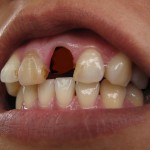
Traumatic damage to permanent teeth has been reported to occur in around 6-34% of children between the ages of 8-15 years of age. Between 0.5-3% of cases the trauma will result in the tooth being completely knocked (avulsion). Damage to the periodontal ligament (PDL) and cementum at the time of injury and how the tooth is stored before reimplantation affects the avulsed tooth’s prognosis. Reimplantation as soon as possible to allow for PDL healing is the primary aim and clinical interventions are aimed at promoting healing.
The aim of this Cochrane review was to assess which treatments for avulsed and replanted permanent teeth were most effective.
Methods
Searches were conducted in the Cochrane Oral Health’s Trials Register, Cochrane Central Register of Controlled Trials (CENTRAL), Medline, Embase, The US National Institutes of Health Ongoing Trials Registry (ClinicalTrials.gov) and the World Health Organization International Clinical Trials Registry Platform. There were no restrictions on language or date. Randomised and quasi‐randomised controlled trials (RCTs) of interventions for avulsed and replanted permanent front teeth with a minimum of 12months follow-up were considered. Standard Cochrane methodological approaches were followed
Results
- 4 studies involving a total of 183 patients (257 teeth) were included.
- 3 studies were considered to be at high risk of bias and 1 at unclear risk.
- 1 study (69 patients, 138 teeth) at high risk of bias compared a 20-minute soak with gentamycin sulphate for both groups prior to replantation with the experimental group receiving daily hyperbaric oxygen for 80 minutes for the first 10 days. For the hyperbaric oxygen group there was some evidence of benefit for oxygen group in respect of periodontal healing, tooth survival, and pulpal healing.
- One study (22 patients 27 teeth) at unclear risk of bias compared the use of Ledermix and Ultracal providing insufficient evidence of a difference for periodontal healing or tooth survival. They did report that Ledermix caused a greater level of patient dissatisfaction with the colour of the treated tooth.
- One study (19 patients) compared extra- or intra-oral endodontics for avulsed teeth which were stored dry for longer than 60 minutes before replantation providing insufficient evidence of a difference in periodontal healing.
- Another study (73 patients) with a high risk of bias compared a 10-minute soak in either thymosin alpha 1 or saline before replantation followed by daily gingival injections with these same medicaments for the first 7 days There was some evidence of a benefit for thymosin alpha 1 with respect to periodontal healing and tooth survival.
Conclusions
The authors concluded: –
Based on the results of the included studies, there is insufficient evidence to support or refute the effectiveness of different interventions for avulsed and replanted permanent front teeth. The overall quality of existing evidence was very low, and therefore great caution should be exercised when generalising the results of the included trials. There is urgent need for further well‐designed randomised controlled trials.
Comments
While it is recommended that replantation of avulsed permanent teeth should take place as soon as possible after the injury as this is almost always the most appropriate action. Preferably this takes place at the time of injury, if not within 90minutes after being stored in a storage medium such as milk.
However, there is currently insufficient evidence for interventions currently used to improve the prognosis for replanted teeth by reducing tooth resorption, ankylosis. The reviewers had difficulty in comparing the available studies when different outcomes have been reported across the studies. However, they do highlight the recent publication of a common outcomes set (COS) for avulsed and replanted teeth. The paper by Kenny et al outlines both what outcomes should be recorded and how they should be collected. If researchers working in this area start using this COS we should see better evidence emerge in due course.
Links
Primary Paper
Day PF, Duggal M, Nazzal H. Interventions for treating traumatised permanent front teeth: avulsed (knocked out) and replanted. Cochrane Database Syst Rev.2019 Feb 5;2:CD006542. doi:10.1002/14651858.CD006542.pub3. Review. PubMed PMID: 30720860; PubMed Central PMCID: PMC6363052
Other references
Kenny KP, Day PF, Sharif MO, Parashos P, Lauridsen E, Feldens CA, Cohenca N,S kapetis T, Levin L, Kenny DJ, Djemal S, Malmgren O, Chen YJ, Tsukisboshi M, Andersson L. What are the important outcomes in traumatic dental injuries? An international approach to the development of a core outcome set. Dent Traumatol. 2018 Feb;34(1):4-11. doi: 10.1111/edt.12367. Epub 2017 Nov 16. PubMed PMID:28873277.
Dental Elf 24th Sept 2018
Root resorption: high incidence after replantation of avulsed teeth
